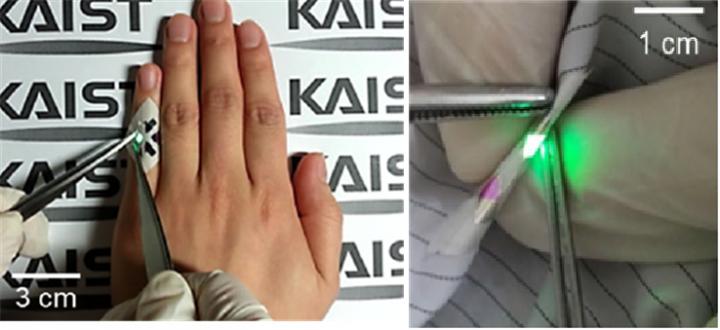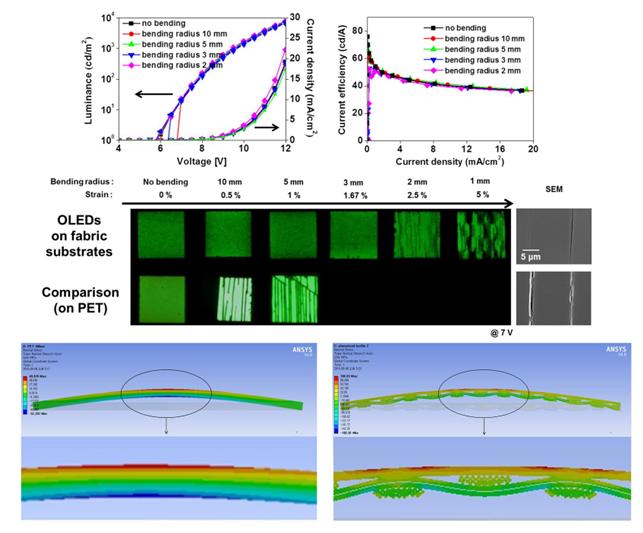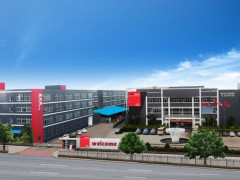
Fabric-Based OLEDs Could Speed Development of Clothing-Shaped Wearable Displays
source:photonics
release:Nick
Time:2017-09-01
DAEJEON, South Korea, Aug. 28, 2017 — Researchers have developed fabric-based organic LEDs that show high luminance and efficiency while maintaining the flexibility of the fabric. These fabrics could lead to soft wearable displays that bend and move with the wearer.
Silicone-based LED jackets, shirts and stage costumes are already available, but the intrinsic stiffness of inorganic semiconductors makes it difficult to use LED-based devices for everyday, comfortable clothing. To create highly flexible clothing-shaped wearable displays, researchers from the Korea Advanced Institute of Science and Technology (KAIST) developed a method of fabricating a thin and flexible light-emitting fabric using OLEDs. The team employed two approaches — fiber-based and fabric-based.

Fiber-shaped OLEDs using rotational thermal evaporation and a polyimide (PI) coated silica fiber were used in the researchers’ first attempt at realizing an emissive fiber. To overcome the low emission performance of fiber-based devices, a dip-coating method capable of depositing layers uniformly was used for the polymer light-emitting diode (PLED) fabrication process. The dip-coated fiber PLED showed luminance of more than
1,400 nit. However, it still needed to be woven and integrated with fiber-based transistors.
Researchers investigated another method — the direct fabrication of an emitting device onto a fabric. This method did not greatly affect the flexibility of fabric, as the substrate was not made of plastic but was an actual fabric.
The fabric substrate used in the research was woven tightly with fine thread to reduce surface roughness. Additive planarization of the fabric was conducted to ensure the operation of a 200-nm-thick OLED. Thermal lamination was implemented to form a flat surface. The planarized fabric was highly flexible compared to the plastic substrates typically used for flexible OLEDs.

The long-term reliability of the fabric-based OLED device was verified through organic and inorganic encapsulation techniques developed by the researchers. According to the researchers, their wearable device facilitates the operation of OLEDs even at a bending radius of two millimeters.
“Having wavy structures and empty spaces, fiber plays a significant role in lowering the mechanical stress on the OLEDs,” said researcher Seungyeop Choi.
The team believes that its work represents the most flexible fabric-based light-emitting device capabilities among any similar technologies reported thus far. Moreover, the team believes that the research could become a guideline for developing the fabric-based electronics industryi
“A screen displayed on our daily clothing is no longer a future technology. Light-emitting clothes will have considerable influence on not only the e-textile industry but also the automobile and healthcare industries,” said professor Kyung Cheol Choi.
Silicone-based LED jackets, shirts and stage costumes are already available, but the intrinsic stiffness of inorganic semiconductors makes it difficult to use LED-based devices for everyday, comfortable clothing. To create highly flexible clothing-shaped wearable displays, researchers from the Korea Advanced Institute of Science and Technology (KAIST) developed a method of fabricating a thin and flexible light-emitting fabric using OLEDs. The team employed two approaches — fiber-based and fabric-based.

Fiber-shaped OLEDs using rotational thermal evaporation and a polyimide (PI) coated silica fiber were used in the researchers’ first attempt at realizing an emissive fiber. To overcome the low emission performance of fiber-based devices, a dip-coating method capable of depositing layers uniformly was used for the polymer light-emitting diode (PLED) fabrication process. The dip-coated fiber PLED showed luminance of more than
1,400 nit. However, it still needed to be woven and integrated with fiber-based transistors.
Researchers investigated another method — the direct fabrication of an emitting device onto a fabric. This method did not greatly affect the flexibility of fabric, as the substrate was not made of plastic but was an actual fabric.
The fabric substrate used in the research was woven tightly with fine thread to reduce surface roughness. Additive planarization of the fabric was conducted to ensure the operation of a 200-nm-thick OLED. Thermal lamination was implemented to form a flat surface. The planarized fabric was highly flexible compared to the plastic substrates typically used for flexible OLEDs.

The long-term reliability of the fabric-based OLED device was verified through organic and inorganic encapsulation techniques developed by the researchers. According to the researchers, their wearable device facilitates the operation of OLEDs even at a bending radius of two millimeters.
“Having wavy structures and empty spaces, fiber plays a significant role in lowering the mechanical stress on the OLEDs,” said researcher Seungyeop Choi.
The team believes that its work represents the most flexible fabric-based light-emitting device capabilities among any similar technologies reported thus far. Moreover, the team believes that the research could become a guideline for developing the fabric-based electronics industryi
“A screen displayed on our daily clothing is no longer a future technology. Light-emitting clothes will have considerable influence on not only the e-textile industry but also the automobile and healthcare industries,” said professor Kyung Cheol Choi.
MOST READ
- RoboSense is to Produce the First Chinese Multi-beam LiDAR
- China is to Accelerate the Development of Laser Hardening Application
- Han’s Laser Buys Canadian Fiber Specialist CorActive
- SPI Lasers continues it expansion in China, appointing a dedicated Sales Director
- Laser Coating Removal Robot for Aircraft
PRODUCTS
 FISBA exhibits Customized Solutions for Minimally Invasive Medical Endoscopic Devices at COMPAMED in
FISBA exhibits Customized Solutions for Minimally Invasive Medical Endoscopic Devices at COMPAMED in New Active Alignment System for the Coupling of Photonic Structures to Fiber Arrays
New Active Alignment System for the Coupling of Photonic Structures to Fiber Arrays A new industrial compression module by Amplitude
A new industrial compression module by Amplitude Menhir Photonics Introduces the MENHIR-1550 The Industry's First Turnkey Femtosecond Laser of
Menhir Photonics Introduces the MENHIR-1550 The Industry's First Turnkey Femtosecond Laser of Shenzhen DNE Laser introduced new generation D-FAST cutting machine (12000 W)
more>>
Shenzhen DNE Laser introduced new generation D-FAST cutting machine (12000 W)
more>>
